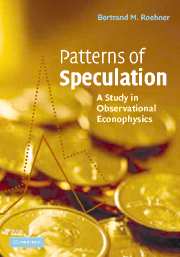Book contents
7 - TWO CLASSES OF SPECULATIVE PEAKS
Published online by Cambridge University Press: 02 December 2009
Summary
In September 1692 a wholesale trader named Massenot who was a purveyor for the “Marine Royale” (French navy) bought 200,000 pounds of wheat in Burgundy at a price of 11 livre per setier (1 setier = 117 kilogram). This was in a fact a forward transaction in the sense that the wheat was to be delivered one half by November 11 and the remainder by December 25. But in the meanwhile the price of wheat increased markedly and by the end of the year it had reached a level of 20 livre per setier. Subsequently, instead of being used by the navy, the wheat was sold to the bakers of the city of Dijon (north of Burgundy) and as a result Mr. Massenot made a handsome profit of 4,000 livres (Martin 1908). The permission to carry out forward transactions was an important privilege of army and navy purveyors; needless to say, as in the above case, that privilege was often used for making huge profits in times of scarcity.
This episode is an illustration of a statement made repeatedly in previous chapters namely that speculation is not limited to financial markets but also occurs in other markets for instance in the markets for commodities, real estate or collectibles. Such speculative movements result in price peaks, which share many common characteristics: same order of magnitude of duration with respect to amplitude, similar shape (as we have seen in a previous chapter). However, a closer examination suggests that there are in fact (at least) two distinct classes of speculative peaks, which will be referred to as the U-class and the S-class.
- Type
- Chapter
- Information
- Patterns of SpeculationA Study in Observational Econophysics, pp. 157 - 176Publisher: Cambridge University PressPrint publication year: 2002



